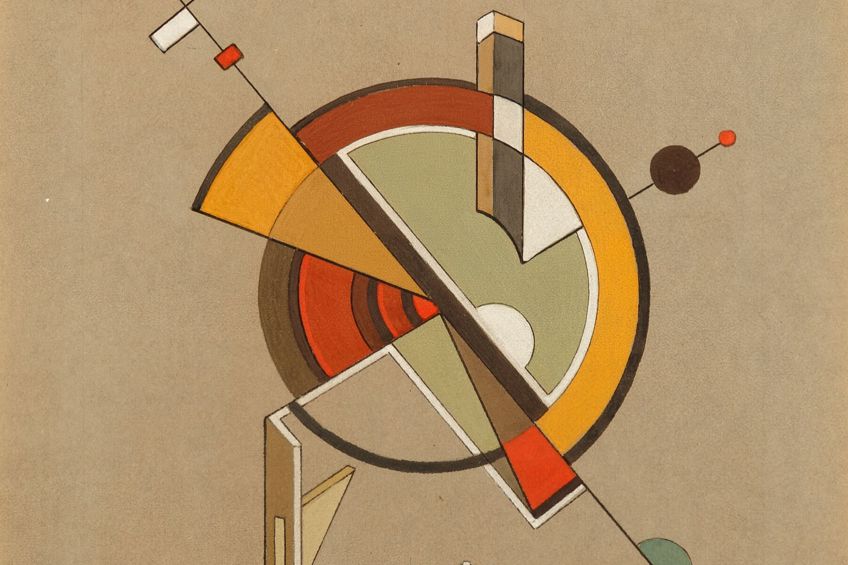Suprematism – Introducing 20th Century Russian Constructivism
The black square remains a significant point of reference for most artists and art lovers, but it is as divisive as it is fascinating. As the star piece in Suprematism art, it can be seen as a pinnacle of the Avant-Garde. Along with other early 20th-century European Avant-Garde movements such as Futurism and Cubism, Suprematism is a quintessential example of modernist abstraction. The very first non-representational paintings are usually attributed to Russian Suprematism. This movement had an immeasurable impact on art history, which we will be taking a look at below.
The Founding of Russian Suprematism
For some viewers, suprematist artworks may appear quite straightforward. That is precisely the intention that motivated this movement. Suprematism artists had the intention of producing work that achieved more than mere representation. They were not concerned with allowing their art to be completely understood. Instead, they encouraged the viewer to think about the painting and enjoy it for what it is.
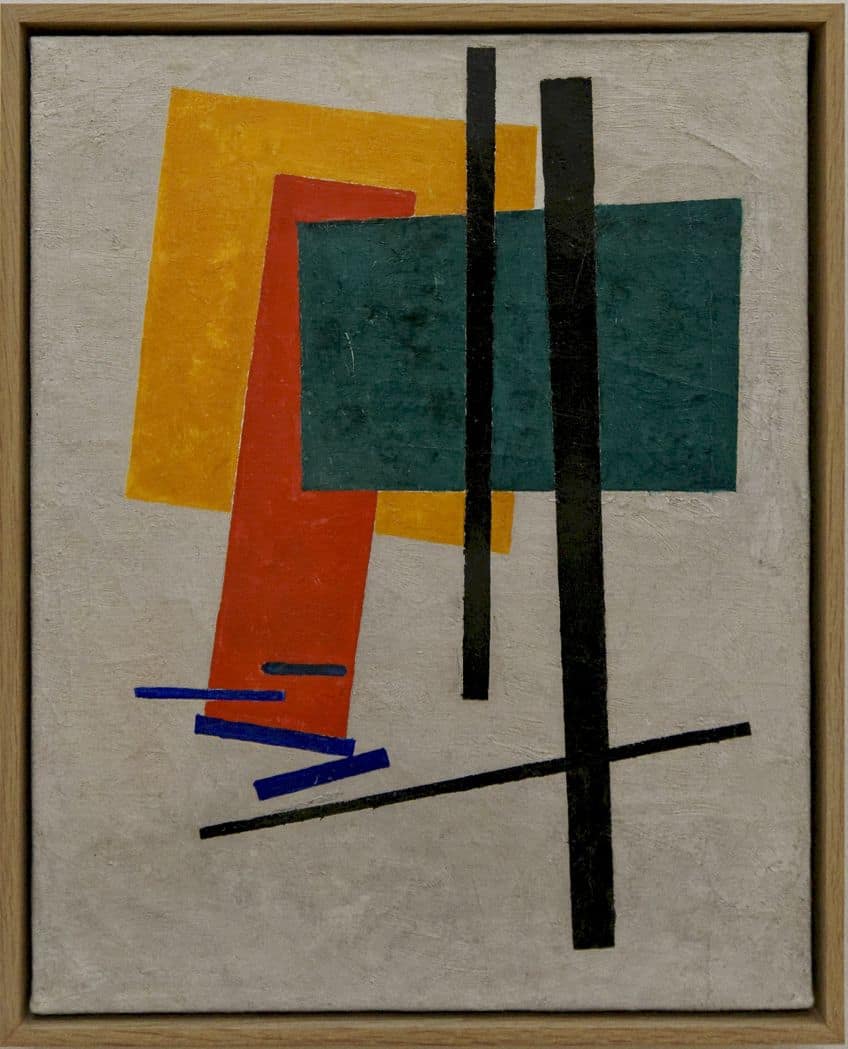
What Is Suprematism?
The suprematism definition describes an art movement established around 1913 by Kazimir Malevich in Russia. Suprematism art is identifiable through its solid geometric forms. It is considered one of the first non-objective art movements. Suprematist artworks did not attempt to trick the viewer into perceiving objects as they existed in reality. Therefore, they were not as concerned with observation or perspective as previous generations had been. Suprematism paintings were less about representation and more about the art object and its effect on the viewer. Focusing on the medium and surface used to create Suprematism art emphasized the painterly process.
Omitting the representation of reality or the cultural meaning of paint, Suprematism highlighted the purity of non-objective painting, thus constituting the foundation of abstraction in Modern art.
Suprematist artworks were purely conceptual and experimented with non-objective, mostly geometric forms, which is the basis of modern abstraction as we know it. The aim was to explore the underlying reality of existence and feeling. Suprematism artworks were icons for meditation driven by what Kazimir Malevich termed “the supreme reality of the world” or “the supremacy of pure feeling or perception in the pictorial arts.” Other than Kazimir Malevich who was the central figure, key Suprematism artists included Olga Rozanova, El Lissitzky, Anna Aleksandrovna Leporskaya, Nikolai Suetin, Konstantin Rozhdestvensky, and Alexander Rodchenko. These artists did not always agree with Malevich’s vision of Suprematism. They had their own ideas about where pure abstraction was headed and would eventually contribute to other movements such as Constructivism and what Rozanova called Color Painting, an early predecessor of Color Field Painting.
The Historical Context of Suprematism
To understand how Suprematism came to be, it is important to understand its context. Russia was submerged in chaos during the early 20th century. Revolutionary communist forces gained popularity while the Russian government retaliated by subjecting its citizens to bloody massacres. Though he was still working with Cubo-Futurism in the early 1900s, Kazimir Malevich, who was himself a communist, believed in a future of endless possibilities and prosperity for Russian art. The reign of Tsar Nikolai II Alexandrovich Romanov ended in 1917 with the triumph of the Russian Revolution. The Tsar and his immediate family were put to death in their home in 1918 by a group of rebels. During the Russian civil war, the leader of the Bolshevik communist forces Vladimir Lenin led the struggle against the remaining supporters of the past government. It wasn’t until 1922 that the Bolshevik red army finally defeated the white loyalists.
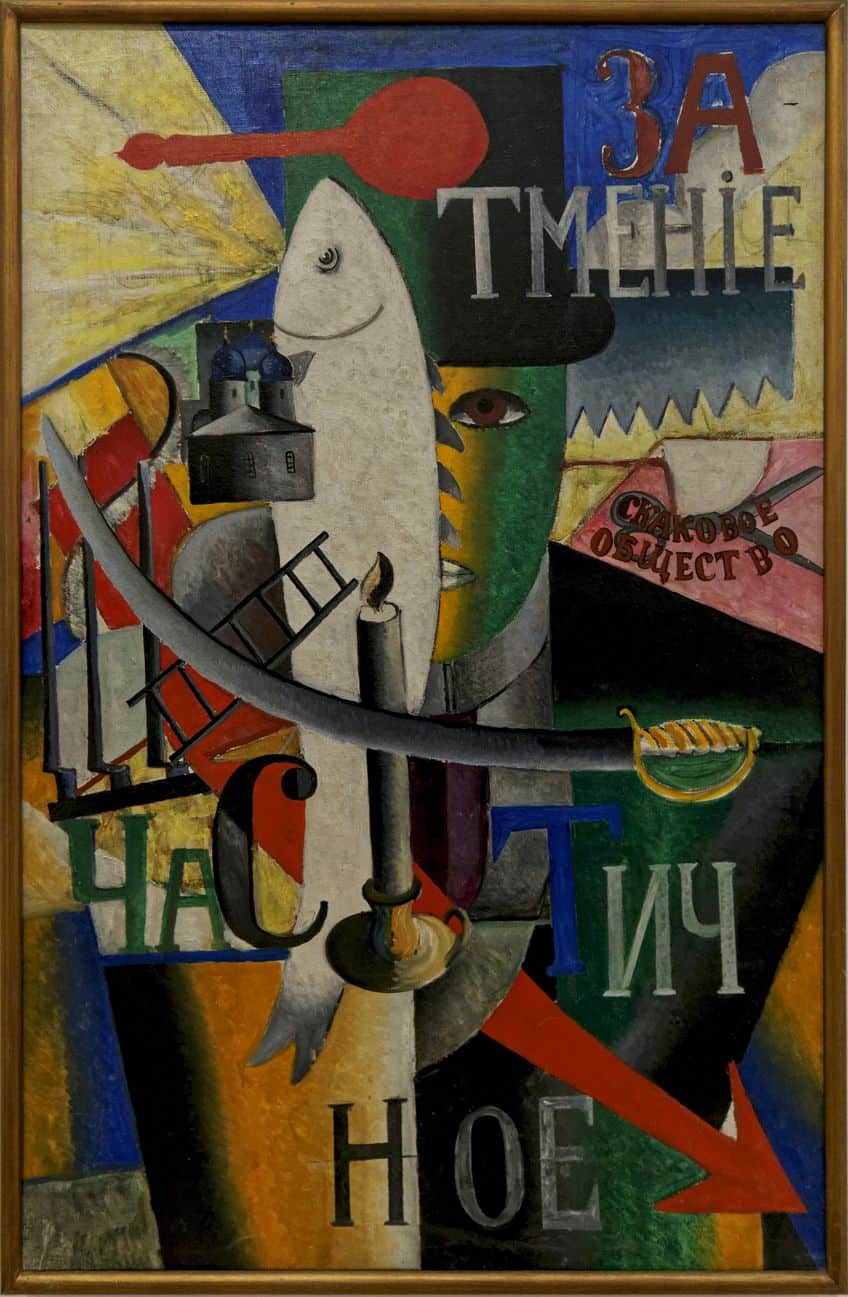
However, Lenin died in 1924 at the age of 53 and his intended successor Leon Trotsky was exiled in 1928, leading to the beginning of Joseph Stalin’s catastrophic reign. Because of his Avant Garde inclinations, Malevich would spend the rest of his life at the mercy of its brutal force. For example, on the 20th of September 1930, Kazimir Malevich was arrested and interrogated by the KGB, then imprisoned for six months. By 1932, Stalin’s dictatorship declared that all art except for educational or socialist realism be destroyed.
Kazimir Malevich
| Birth and Death | 23 February 1879 – 15 May 1935 |
| Place of Birth | Kyiv, Ukraine |
| Nationality | Russian |
| Associated Art Movements | Suprematism, Cubo-Futurism, Russian Futurism, and Geometric abstraction |
The Russian artist Kazimir Severinovich Malevich is widely regarded as the sole founder of the movement known as Suprematism. Prior to coining this term Malevich was part of the Cubo-Futurism art movement, which emerged in the early 20th century. Being the main artistic mode for the painters and sculptors known as Russian Futurists, Cubo-Futurism was a combination of Italian Futurism and French Cubism. In 1913 Kazimir Malevich was invited to produce the costume and set design for the anti-rationalist, anti-establishment, Cubo-Futurist opera Victory Over the Sun. Produced in collaboration with Zaum poets Velimir Khlebnikovwere and Aleksei Kruchenykh and composer Mikhail Matyushin, Victory Over the Sun was staged in St. Petersburg.
The show was essentially incomprehensible, its script consisting of nonsensical words following an offbeat and jarring plot.
Malevich based his stage design on extremely minimalist forms. He painted a single black square on a white backdrop, but it wasn’t until the second staging, two years later that Malevich realized that this had been the initial iteration of his new movement Suprematism. With that, the artist wrote his manifesto From Cubism to Supremacism in 1915, effectively changing the course of history. On the 19th of December 1915, Malevich opened The Last Futurist Exhibition of Painting 0.10 (Zero-Ten) in Petrograd. Though 14 artists including Ivan Puni, Ivan Klyun, Mikhail Menkov, Kseniya Boguslavskaya, Lyubov Popova, and Olga Rozanova ended up participating, the exhibition title refers to the 10 artists initially involved in the show. The zero stands for the fundamental commonality of their practices – that they intended to reduce everything to zero. This collective reduction of form is where Malevich officially launched Suprematism.
Among the work of other artists such as the counter-relief sculptor Vladimir Tatlin, the show featured twenty of Malevich’s paintings, twelve of which are known to still be in existence today. As the exhibition was incredibly dense, the way Malevich exhibited his paintings could be mistaken as fragmented or haphazard. His Suprematism paintings were scattered across the gallery walls which gave the exhibition an incredible sense of movement. The placement of the individual paintings brought a quiet balance to the layout. Being mounted across the two angles where the wall met, the artworks mirrored one another. The primary artwork was placed in a location usually reserved for religious iconography in Russian Orthodox homes. The colorful arrangements and the shapes within individual paintings created an extremely dynamic composition. A composition that implied a constellation intended to be read in its entirety.
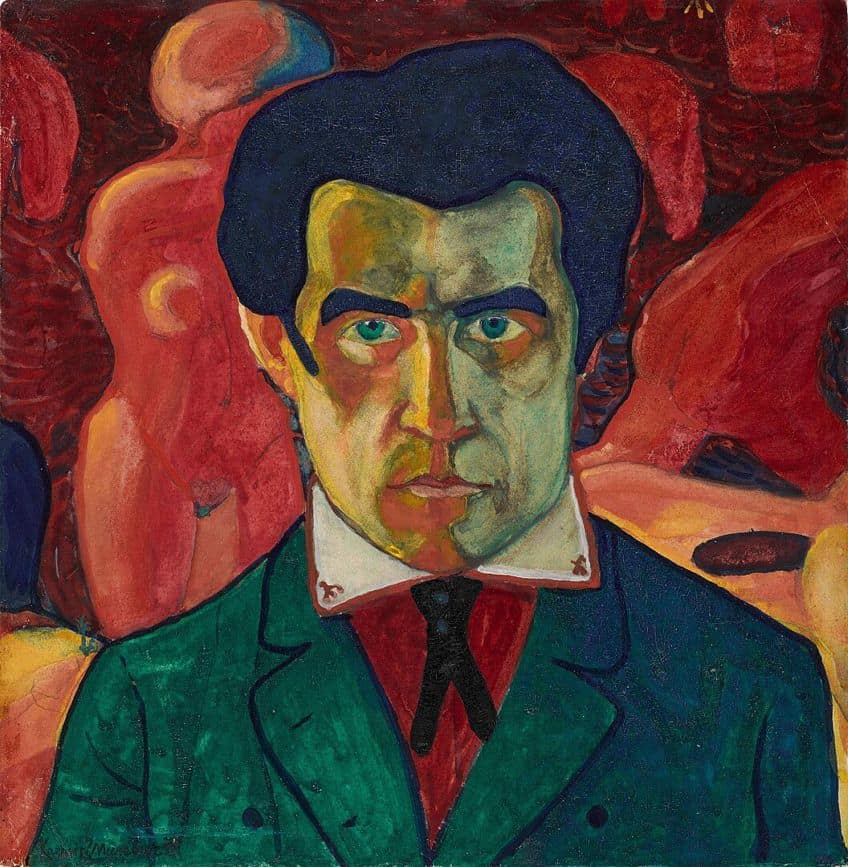
Although some recognized the triumph of Suprematism Malevich was tormented and persecuted ever since the onset of Bolshevik Russia in 1917. He was under constant surveillance and stood accused of spying or being involved in counter-revolutionary campaigns. He was repeatedly arrested, imprisoned, and tortured. In 1927 Malevich had his first solo shows in Warsaw and Berlin, gaining recognition in the West. However, the artist developed cancer and would die only a few years later from hunger-induced tuberculosis.
Despite the dramatically poor living conditions imposed upon him by his own government, Malevich remained artistically active until the bitter end. Because of his contributions to Suprematism, and the influence it had on other European Avant Garde movements, Malevich is seen as one of the primary figures in the development of Modern art. Below are some iconic examples of Malevich’s contribution to Suprematism art.
The Black Square (1915)
| Artist | Kazimir Malevich |
| Date | 1915 |
| Medium | Oil on linen |
| Dimensions (cm) | 79.5 x 79.5 |
| Where It Is Housed | Tretyakov Gallery, Moscow, Russia |
At The Last Futurist Exhibition of Painting 0.10, Black Square was the star of the show. Displayed in the center of the exhibition and hung high, almost flush with the ceiling, across the corner of the room, the painting was positioned in a spot usually reserved for religious images in Orthodox Russian households. Thus, Black Square could be read as an object of devotion.
In 1915, Malevich produced his first of four Black Square paintings. He claimed to have created a code within these paintings, which was meant to encompass all art forms as the square was an elementary shape that all artists used.
Black Square removes all references to the physical world. It is quite literally a black square surrounded by a white border. Recent research has uncovered some intriguing information about the underpainting behind Black Square. The cracks on the surface make it so that even without x-ray technology, the viewer can faintly perceive the underpaintings, giving the painting’s surface an intriguing texture. With Black Square Malevich made a profound statement about his artistic philosophy, establishing a solid foundation for Suprematism. This image is important not just because of its painterly quality. It is recognized for its cultural, social, and historical significance. Malevich’s Black Square was one of the most influential paintings of the 19th century and is considered the quintessential Suprematist painting.
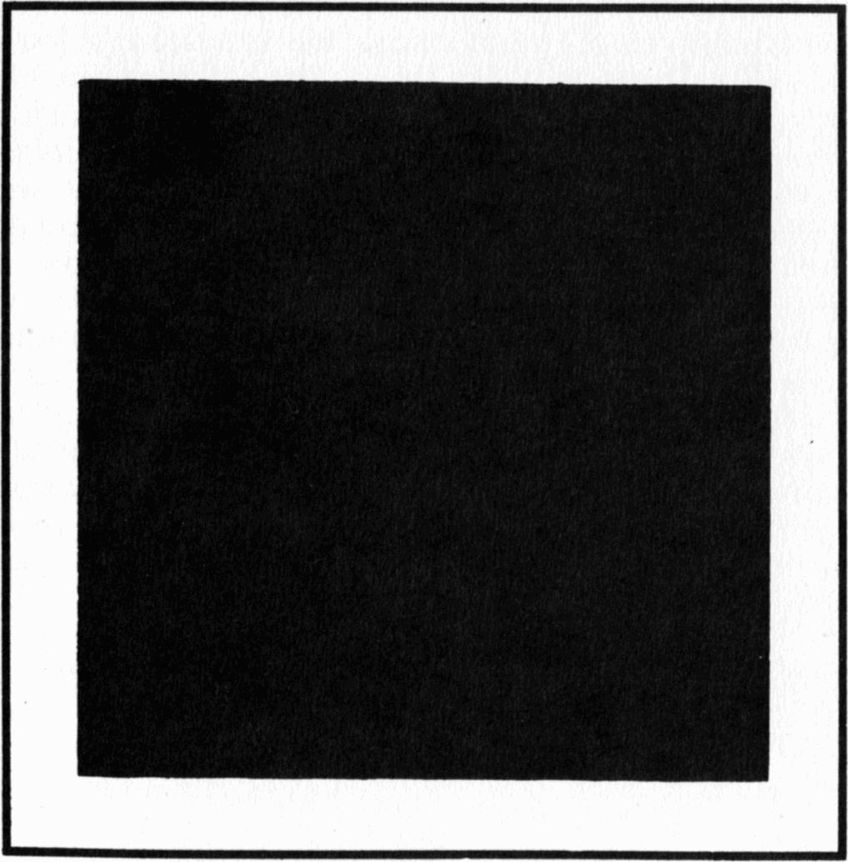
Red Square/Painterly Realism of a Peasant Woman in Two Dimensions (1915)
| Artist | Kazimir Malevich |
| Date | 1915 |
| Medium | Oil on canvas |
| Dimensions (cm) | 53 x 53 |
| Where It Is Housed | Russian Museum, Saint Petersburg, Russia |
Malevich’s Red Square (1915) is otherwise known as Painterly Realism of a Peasant Woman in Two Dimensions. This alternative title sheds light on the artist’s conceptual process. Red is an evocation of traditional Russian religious icon paintings as well as the peasant woman referred to in the title of the piece. This painting was produced during a time when non-objective art was not only frowned upon but dangerous.
While the artist leaves plenty of room for the viewer to bridge the link between the painting and the concept, he does not shy away from decisiveness.
Red Square shows a white field behind a red quadrilateral, representing the purest form of simplicity. Malevich claimed that red and white constituted the entire color spectrum. Therefore, for him, this painting represented all colors. There is an effective use of contrasts in Red Square, as red is the active color, while white seems passive. Malevich called Suprematism artworks such as Red Square, the “final chapter in the development of easel painting.” Red Square was not just a rejection of representational art, but a response. It represented Malevich’s notions of the weightlessness of pure form. While Red Square was criticized by the artist’s contemporaries at the time, it was a triumph for the development of modern abstraction. In the artist’s eyes, this was not just a painting, but a meaningful symbol of suprematism art.
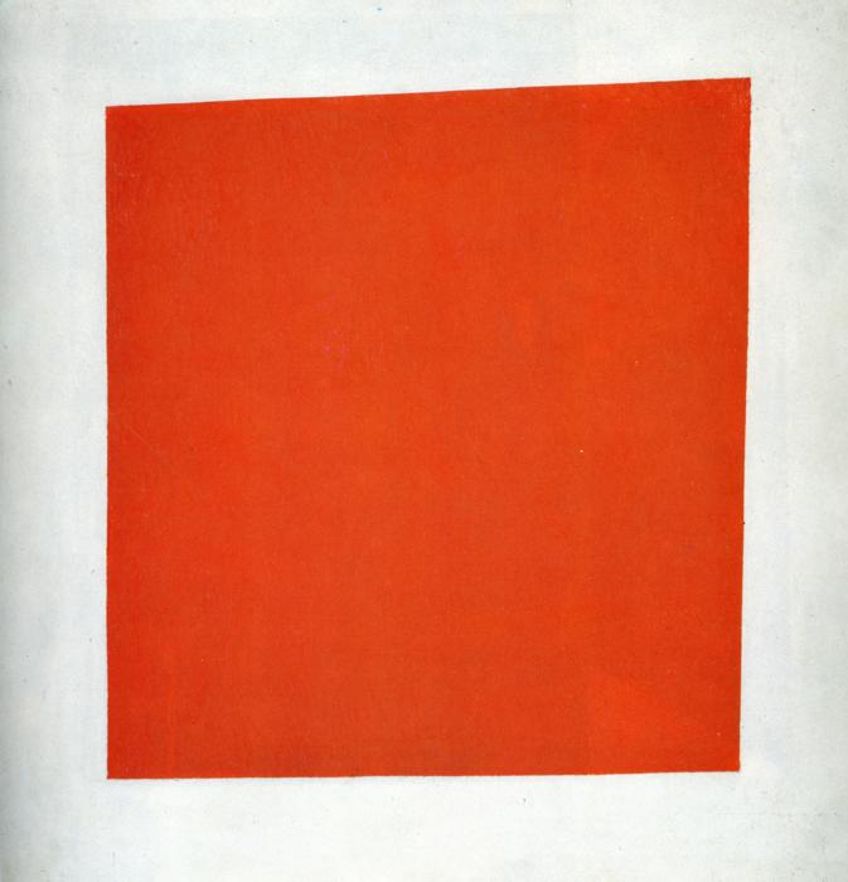
White on White (1918)
| Artist | Kazimir Malevich |
| Date | 1918 |
| Medium | Oil on canvas |
| Dimensions (cm) | 79.4 x 79.4 |
| Where It Is Housed | Museum of Modern Art, New York City, United States |
Like most of his work, Kazimir Malevich’s Suprematist Composition: White on White is an oil on canvas painting. Two white squares span the canvas, one white square weightlessly floating diagonally within another. Paradoxically, the subtle variations between the two white fields produce a flat three-dimensionality within the composition.
Because this work makes no effort to represent objects as they appear in real life, it does not need conventional perspective.
While all that exists is a seemingly colorless geometric abstraction with no reference to the external world, this example of Suprematism art does not completely abandon perspective. As the square is not quite straight or symmetrical, the spatial orientation of the piece produces a sense of motion and limitless space. This Suprematism artwork does not abandon its sense of color either. It may be colorless, but this fact is used as a cunning artistic device. Choosing these subtle variations of white directs the viewer’s attention not to the color, after which the work is titled, but to the method and the medium. White on White‘s colorlessness does not make it devoid of artistic touch. Indeed, the artist’s hand is seen in the texture of the paint. Malevich’s brushwork is visible. His imprecisely ruled lines and uneven surface give the piece a living quality.
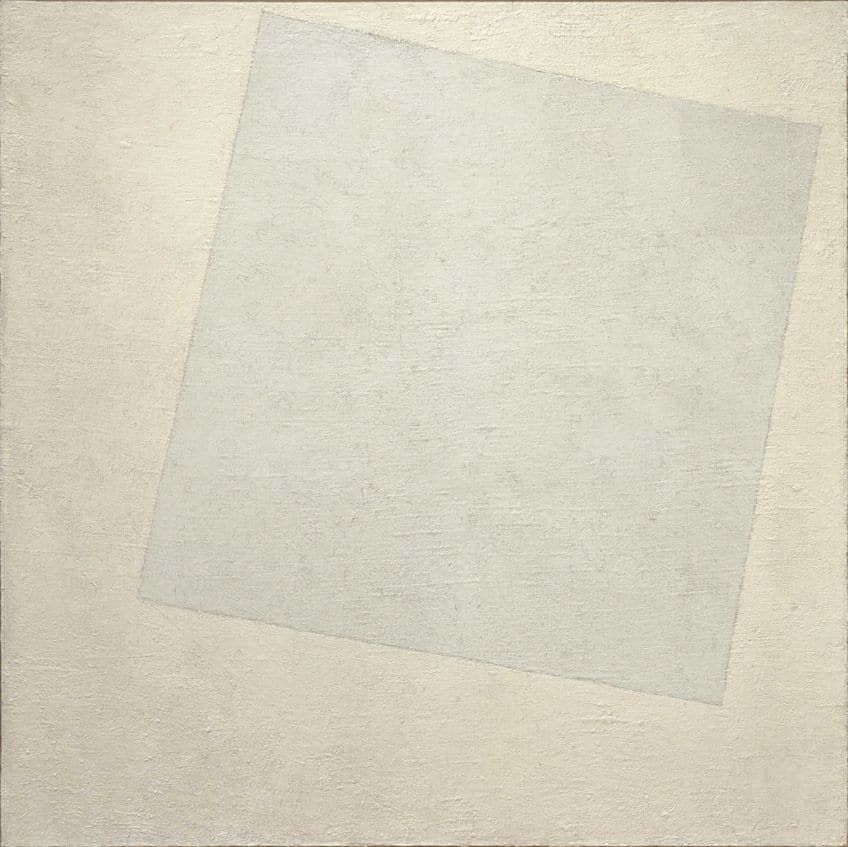
A Love Supreme
From Cubo-Futurism to Suprematism and more contemporary forms of non-objective art, the motivation has always been to inspire the appreciation of art for art’s sake. To not wish for art to resemble anything but itself. In that sense, Suprematism is made for insatiable lovers of art; for those who do not require it to imitate life, and who love it enough to let it simply exist. After its inception, Suprematism quickly gained international fame, with many Suprematism artists becoming major avant-garde cultural figures. Kazimir Malevich’s celebrated protege El Lissitzky, was a central figure in the development of later avant-garde movements such as Constructivism, Bauhaus, and De Stijl. Russian Suprematism was swiftly surpassed by these much larger European abstract art movements, but it was never forgotten.
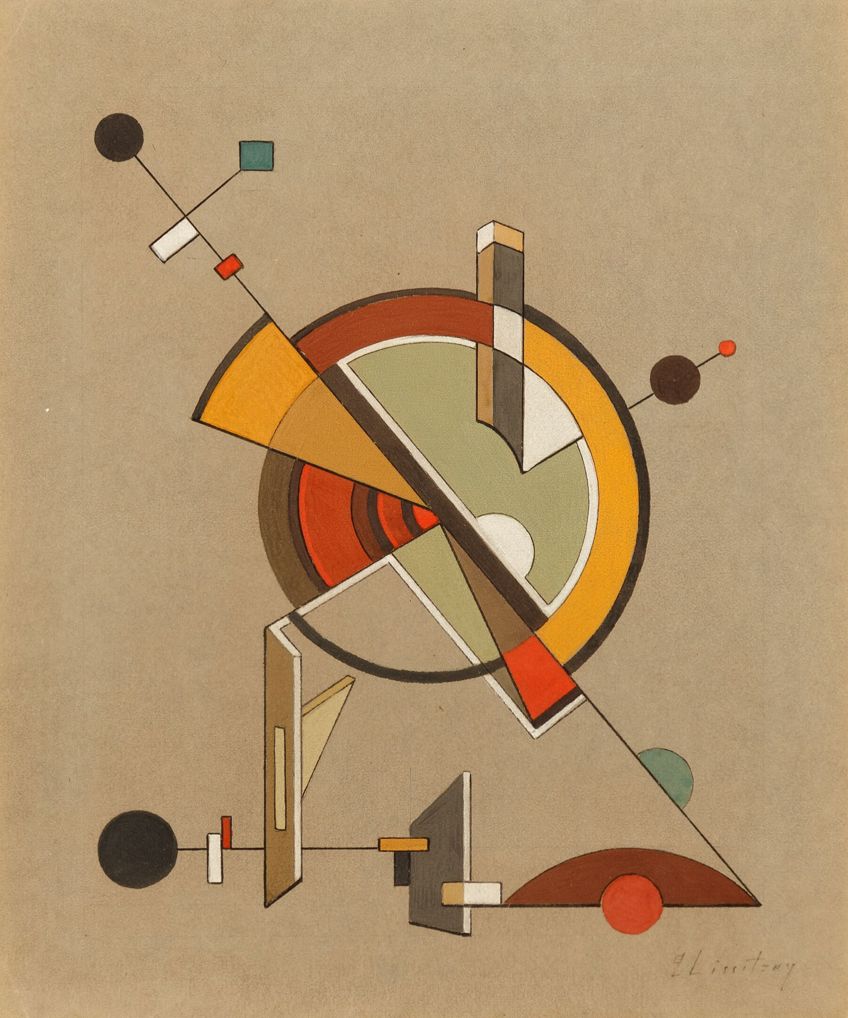
While it is common to mistakenly associate Kazimir Malevich with the artistic movement of Constructivism, the artist was staunchly opposed to it. Notwithstanding the differences between Suprematism and Constructivism, and other abstract art movements, the combined wave of European Avant-Garde sentiments swept across the globe, birthing what is now known collectively as Modernism in art.
Despite its vast contributions, Suprematism was relatively short-lived and is often criticized for its cultural limitations. Along with its more recent tributaries such as Post-painterly Abstraction and Zombie Formalism, Suprematism‘s commitment to form has failed to respond to Postmodern concerns. The suprematist notion of valuing art based purely on its formal aspects does not take the politics of access and cultural determinism into account.
Frequently Asked Questions
How Much Is Russian Suprematism Art Worth?
Kazimir Malevich’s Suprematism paintings hold world records as some of the most valuable Russian art in history. One of Malevich’s Black Square Suprematism paintings sold for $1 million in 2002. In 2008, Malevich’s highly popular and influential work, Suprematist Composition (Blue Rectangle Over Red Beam) (1916), sold for over $60 million.
How Many Suprematism Paintings Did Kazimir Malevich Have?
It is difficult to know precisely how many works Malevich produced during the advent of Suprematism. The suggestion is that in total, Kazimir Malevich produced 85 Suprematism paintings. 22 of these works were either lost or destroyed, while 47 of them remain in public collections around the world.
Is Suprematism Similar to Supremacy?
Art historians often point out the distinction between the Suprematism definition and supremacy, making sure to distance the art movement from some of the more troubling political sentiments of the time. However, Suprematism is a descendant of Futurism, which has direct associations with fascism. The political implications of Suprematism were further called into question when researchers uncovered an inscription beneath the black paint of Malevich’s Black Square that reads: Negroes battling in a cave.
Was Suprematism Influenced by Science?
Yes and no. To some degree, Suprematism was an anti-rationalist movement. Not only was its founder, Kazimir Malevich, inspired by an anti-rationalist form of Russian Futurist poetry called Zaum, but he was also interested in mythical ideas, hoping his art would inspire the viewer to contemplate or commune with the divine. At the same time, other Suprematism artists such as Alexander Rodchenko rejected these mystical ideas, preferring to make connections with logic, science, and the laws of physics.
Which Artist Discovered Non-Representational Art?
This is a highly contentious question. What is clear is that Russian artists of the early 1900s were highly influential in the development of non-representational art. Many art historians credit Wassily Kandinsky as the father of non-representational art. Kazimir Malevich was heavily influenced by Kandinsky.
Liam Davis is an experienced art historian with demonstrated experience in the industry. After graduating from the Academy of Art History with a bachelor’s degree, Liam worked for many years as a copywriter for various art magazines and online art galleries. He also worked as an art curator for an art gallery in Illinois before working now as editor-in-chief for artfilemagazine.com. Liam’s passion is, aside from sculptures from the Roman and Greek periods, cave paintings, and neolithic art.
Learn more about Liam Davis and about us.
Cite this Article
Liam, Davis, “Suprematism – Introducing 20th Century Russian Constructivism.” artfilemagazine – Your Online Art Source. September 28, 2023. URL: https://artfilemagazine.com/suprematism/
Davis, L. (2023, 28 September). Suprematism – Introducing 20th Century Russian Constructivism. artfilemagazine – Your Online Art Source. https://artfilemagazine.com/suprematism/
Davis, Liam. “Suprematism – Introducing 20th Century Russian Constructivism.” artfilemagazine – Your Online Art Source, September 28, 2023. https://artfilemagazine.com/suprematism/.


